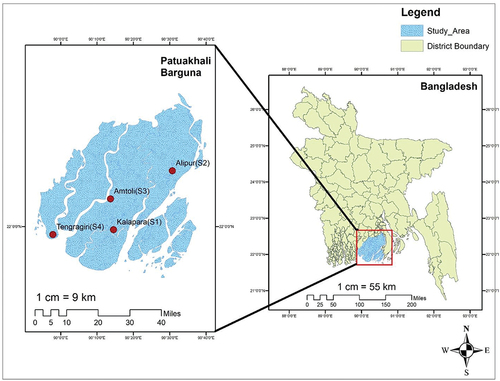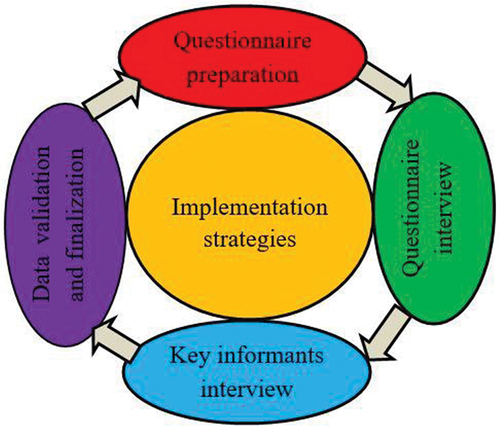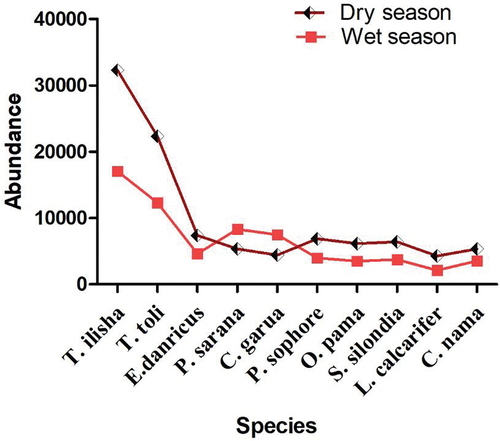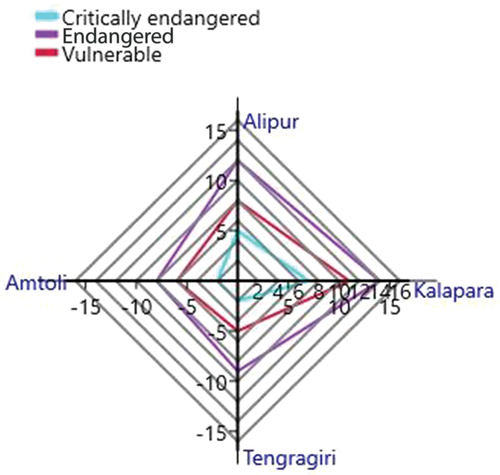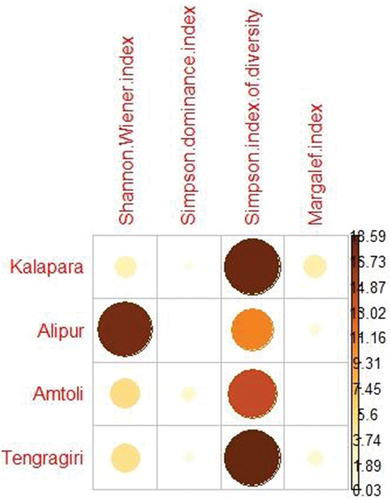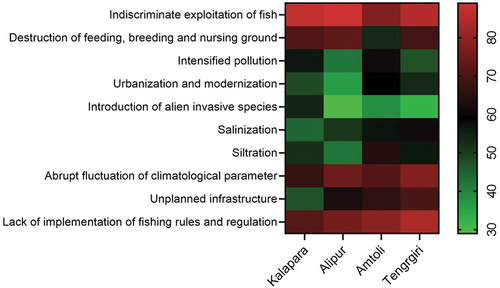 ?Mathematical formulae have been encoded as MathML and are displayed in this HTML version using MathJax in order to improve their display. Uncheck the box to turn MathJax off. This feature requires Javascript. Click on a formula to zoom.
?Mathematical formulae have been encoded as MathML and are displayed in this HTML version using MathJax in order to improve their display. Uncheck the box to turn MathJax off. This feature requires Javascript. Click on a formula to zoom.Abstract
The south-central coastal waters of Bangladesh are recognized as one of the foremost aquatic biodiversity hotspots despite severe anthropogenic and environmental hazards to natural fishery resources. Therefore, this study was undertaken to examine the current status of fish faunal diversity and evaluate the condition and conservation status of fish in the rivers spanning the south-central coastal region of Bangladesh. During the research period, spanning from July 2021 to February 2022, a total of 105 fish faunal species belonging to 84 genera, 50 families, and 14 orders were documented. The order Perciformes (27.62%) was found to be the most diverse fish group, followed by Cypriniformes and Scombriformes (12.38%), Siluriformes and Clupeiformes (11.43%), Synbranchiformes and Pleuronectiformes (3.81%). According to the International Union for Conservation of Nature (IUCN) Red List classification, 52 species recorded from the studied areas were determined to be of Least Concern, while 11 species were Vulnerable, 14 species were classified as Endangered, and 7 species are recognized as Critically Endangered. In order to assess the species diversity, richness, and evenness of the fish assemblage in the sampling areas, four diversity indices, viz. the Shannon-Wiener index (H), Simpson’s dominance index (D), Simpson’s index of diversity (1-D), and Margalef’s index (d), were applied. Their overall values were 3.39–3.59, 0.05–0.07, 0.95–0.94, and 7.67–8.75, respectively. All of the species were more or less evenly distributed throughout the three sites, with Kalapara having the most even distribution. Several anthropogenic and natural attributes that contribute to decline in fish diversity were recorded using a survey questionnaire which revealed that management and conservation measures should be taken with utmost urgency.
Introduction
Food security and nutrition are put at risk due to biodiversity loss which poses a significant challenge in the 21st century. Due to the decline of fishing resources, this concern is especially acute in many coastal and inland areas. Overexploitation of fish, climate change and many other anthropogenic activities including siltation, pollution of aquatic environments through industrial chemicals, indiscriminate use of fertilizers and insecticides, and disturbances of breeding, nursery, and feeding grounds all synergistically affect fish biodiversity (Colossi et al. Citation2019). Diversity of fish and resilient fisheries are deemed two key milestones to meet the ever-growing demand for fish consumption in Bangladesh, but it is difficult to find management strategies that address both food and nutritional security and biodiversity.
Bangladesh is bestowed with abundant and diverse fishery resources due to its enormous riverine network (Rahman Citation2015). Coastal rivers in Bangladesh are considered an indispensable, balanced ecosystem providing natural breeding, feeding, and nursery grounds for many economically important fisheries resources (Aminul Islam et al. Citation2015). Fishing has long played a vital part in the country’s national economy, serving as the prime source of animal protein, employment opportunities, food and nutritional security, foreign earnings, and socioeconomic advancement (Siddiq et al. Citation2013; Ali et al. Citation2014, Citation2015). The most productive and dynamic source of income for the population is fishing, which has an impact on the country’s agricultural economy (Shamsuzzaman et al. Citation2020). Patuakhali is the south-central coastal district of Bangladesh blessed with diversified fisheries resources and considered an important economic hub of the coastal region of Bangladesh (Ali et al. Citation2020).
The productivity and richness of a water body are greatly influenced by its biodiversity. The diversity of species in a water body is typically influenced by both human activity and natural calamities. Unplanned construction of dams and bridges, changing the river flow course, loss of habitat, water pollution from industrial and agricultural waste, alien species invasions, heavy exploitation of larvae and juvenile fish stocks, and the use of illegal fishing gear are the most impactful anthropogenic causes of biodiversity depletion in coastal ecosystems (Sarkar et al. Citation2008; Rahman Citation2015). In addition, natural causes like floods, sudden alteration of meteorological and hydrological parameters, algal blooms, and siltation can have an impact on fish biodiversity (Hossen et al. Citation2020; Jahan et al. Citation2020; Pandit et al. Citation2021). Considering the above-mentioned circumstances, it is urgently necessary to take proper initiatives for the conservation of aquatic biota and maintain sustainable utilization levels (Fu et al. Citation2003; Eros & Schmera Citation2010; Rao et al. Citation2014).
The state of the complex network of biological entities in an ecosystem is evaluated via diversity analysis (Joshi et al. Citation2017). The diversity index stands as a valuable tool offering crucial insights into the distribution of species, indicating both occurrence and abundance within a community in a specific water body (Tikadar et al. Citation2021). Many studies regarding biodiversity of fishes have been performed in Bangladesh and around the world (Uttam & Bain Citation2007; Montaña et al. Citation2011; Chowdhury et al. Citation2011; Mukherjee et al. Citation2013; O’Hara et al. Citation2019; Akhi et al. Citation2020), but to date, reports on the composition, distribution and community structure of fish fauna in southern coastal regions of Bangladesh are limited. Consequently, the purposes of the study were to evaluate the present status of the ichthyofaunal assemblage, identify the main causes contributing to the depletion of fish biodiversity, and formulate recommendations for the conservation of fish faunal diversity.
Materials and methods
Study area
The study was conducted for a period of 6 months, from July to September 2021 (wet season) and from December 2021 to February 2022 (dry season), in order to obtain fish faunal diversity data in two south-central coastal regions (Patuakhali and Barguna) of Bangladesh. The survey areas were divided into four sampling stations (): Kalapara (S1, 21°98′61″N, 90°24′22″E), Alipur (S2, 22°25′55.0″N, 90°51′16.2″E), Amtoli (S3, 22°12′71.9″N, 90°22′82.5″E), and Tengragiri (S4, 21°96′34.79″N, 89°96′42.68″E).
Data collection
To conduct this research, both primary and secondary data was used. Fish fin samples were procured from local fish landing centers, obtained both during the catch and from fishermen who had been asked beforehand. In the studied area, local fishermen utilize a diverse array of fishing gear, including set gill nets, seine nets, drift gill nets, cast nets, moshari bar jal, hooks, and traps. This gear varies in terms of specific species targeted, size, and overall efficiency. From the study sites, pertinent information was gathered, including the local names of the different fish species that were taken as well as the source, availability, and dispersion of the species. Secondary data was gathered from the Department of Fisheries (DoF), the Statistical Yearbook of Bangladesh, and District Fisheries Offices. In addition to these statistics, relevant documents were also gathered from a number of governmental organizations, independent entities, and non-governmental organizations (NGOs). In order to assemble historical data of abundance and availability for evaluating biodiversity status, research articles on the fish faunal diversity of Bangladesh were also considered. Key informant interviews were conducted in order to understand the threat assessments in the research area ().
Collected sample identification
Based on the primary physical characteristics, the collected fish species were systematically organized. Those species that posed challenges in identification onsite were transported to the Molecular Biology and Conservation Laboratory at Patuakhali Science and Technology University, Bangladesh. Fish were transported in a 5–10% buffered formalin solution. Fish collected from the sampling areas were identified by analyzing their morphometric and meristic traits according to previously published data (Hussain Citation2010; Eschmeyer Citation2022). Following identification, fish species were systematically categorized according to Bell (Citation2006) and Nelson (Citation2006).
Fish abundance and biodiversity status analysis
In this study, fish species abundance and diversity was analyzed using several indices, viz. the Shannon-Wiener diversity index (H), Simpson’s dominance index (D), Simpson’s index of diversity (1-D), Margalef’s index (d) and the evenness index (E).
Shannon Weiner diversity index (H)
This index evaluated both the number of species and the distribution of individuals among species. Values of this index were evaluated on a monthly basis by applying the following equation:
where Pi = ni/N; ni = number of individuals of each species in the sample, and N = total number of individuals of all species in the sample.
Simpson’s dominance index (D)
This index is often used to quantify the biodiversity of a habitat, taking into account the number of species as well as the abundance of each species. The equation used for calculating Simpson’s dominance index is:
Simpson’s index of diversity (1-D)
Simpson’s index of diversity was calculated using the following formula:
Margalef’s diversity index (d)
To measure species richness, Margalef’s diversity index can be assessed using the following formula:
Evenness (E)
The evenness index, or the relative abundance of the different species making up the richness of an area, was calculated using the following equation.
where H = Shannon Weiner diversity and S = total number of fish species.
Analyses of the various diversity indices were carried out using the Paleontological Statistics (PAST) version 4.03 software program. Graph pad Prism 8 and R programming were used to conduct statistical analyses. A dendrogram was constructed using the results of the hierarchical clustering in order to compare the examined stations (Clarke et al. Citation2014).
Results
The study area represents a natural hub for a diverse array of marine and freshwater species spaning various orders and families. The collection of data involved engaging in discussions with 215 fishermen from the local fishing community and surveying distinct fish landing centers. This comprehensive approach was undertaken with the goal of augmenting the species checklist within the designated study area.
The present study recorded a total of 105 species of fishes belonging to 84 genera, 50 families and 14 orders. displays the conservation status (International Union for Conservation of Nature (IUCN) and Bangladesh Red List status) of the species found in the study area, accompanied by their order, family, scientific name, and common name. Out of 14 orders, Perciformes contributed the most, with a share of 27.62% of the total catch, followed by Cypriniformes and Scombriformes (12.38%), Siluriformes and Clupeiformes (11.43%), Synbranchiformes and Pleuronectiformes (3.81%), Acanthuriformes, Anguilliformes Carangiformes, Mugiliformes, and Tetraodontiformes (2.86%), whereas Myliobatiformes (1.90%) and Aulopiformes (0.95%) were least dominant (). According to our study, the dominant family was Cyprinidae, comprising 13 species which accounts for 12.38% of the total number of observed species. Other dominant families were Gobiidae (8.57%) and Scombridae (8.57%), while Clupeidae, Sciaenidae, Bagridae, Ariidae, Cynoglossidae constituted 3.80% species each.
Figure 3. Percentage composition of families, genera and species of ichthyofaunal diversity documented in the south-central coastal regions of Bangladesh.
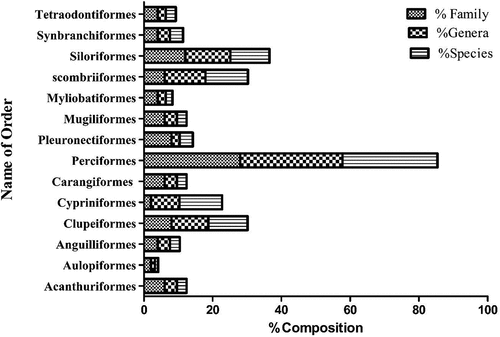
Table I. Ichthyofaunal abundance and conservation status of recorded individuals at four stations in the south-central coastal regions of Bangladesh.
In all of the research regions, the dry season (December 2021 to February 2022) revealed a higher abundance of fish species in contrast to the wet season (). Kalapara station exhibited the highest diversity of 101 species, followed by Alipur (97), Tengragiri (93), and Amtoli stations (85). The maximum number of individuals (91,884) was recorded at sampling station S1, followed by S2, S4, and S3 where 80,442, 61576, and 57,202 individuals were found, respectively (). In terms of recorded species richness and abundance, Perciformes was found to be the dominant fish order, followed by Cypriniformes and Siluriformes, among the four stations. During the study period, 10 of the 105 species were most prevalent, with Tenoalosa illisha taking the highest rank and being followed in abundance by T. toli, Esomus danricus, and Puntius sarana. The least prevalent species in both the dry and wet seasons were Lates calferifer and Chanda nama ().
Table II. Total number of fish species and individuals identified from four stations in the south-central coastal waters of Bangladesh.
In accordance with the IUCN Red List categories, 11 species were recorded as Vulnerable, 14 species were identified as Endangered, 7 species were Critically Endangered, and 52 species recorded from the researched areas were found to be of Least Concern. Out of the 105 fish species, 64 Bangladesh (BD) red-listed species were recorded from the study locations, of which 2 species were found to be Critically Endangered, 5 species were identified as Endangered, 7 species were Vulnerable, and 37 species were deemed to be of Least Concern (). Our study demonstrated that compared to other stations under examination, Kalapara station recorded the majority of the threatened species as per IUCN.
Figure 5. Conservation status of fish species recorded in our study under International Union for Conservation of Nature (IUCN) and Bangladesh (BD) red list categories.
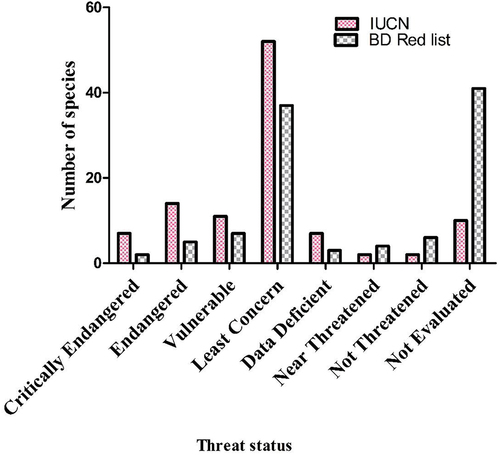
The Kalapara station had the highest number of critically endangered fish species (7 in total), whereas Amtoli and Tengragiri had the lowest numbers (both 2). In contrast to Amtoli, which had the lowest number of endangered species (8), and Tengragiri, with the fewest vulnerable species (5), Kalapara demonstrated the highest figures of endangered and vulnerable species, at 14 and 11, respectively ().
In , the values of several diversity indices for the four research sites are displayed. The highest (3.462) and lowest (1.927) levels of Shannon-Weiner diversity index value were found in Kalapara (S1) and Amtoli (S3), respectively. Simpson’s dominance index data showed that Amtoli (S1) had the highest value, followed by Tengragiri (S4), Alipur (S2), and Kalapara (S1), with values of 0.062, 0.061, and 0.048, respectively. The maximum and minimum values of Margalef’s richness were found in S1 and S3, respectively. The evenness value showed that all of the species were more or less evenly distributed among the four stations, with S1 having the most even distribution ().
A cluster analysis was performed on the recorded species from the sample sites. The study found that the species were divided into two major clusters and shared 95% similarity, according to the Bray-Curtis similarity matrix. Stations Amtoli and Tengragiri constituted one cluster while Kalapara and Alipur formed another ().
Figure 9. The temporal fish assemblage cluster constructed as per the Bray-Curtis similarity matrix.
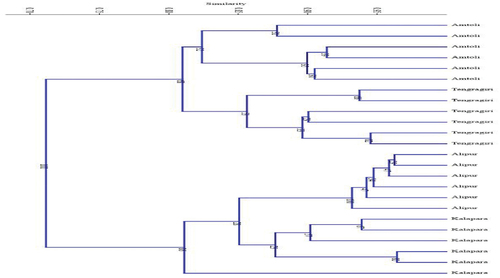
The factors that contribute to declining ichthyofaunal diversity include indiscriminate fishing, destruction of feeding, breeding, and nursing grounds, pollution, urbanization and modernization, introduction of alien invasive species, salinization, siltation, abrupt changes in climatological parameters, unplanned infrastructure, and a lack of enforcement of fishing regulations. According to the respondents, the main threats to the depletion of fish faunal resources in the research area include overfishing, habitat degradation, the effects of climate change, and a lack of compliance with fishing laws and regulations ().
Discussion
Research into fish biodiversity often reveals the variability of species within a given location. Documentation of the current fish population, alongside its ecosystem and biodiversity status, is crucial for adapting to the changing conditions worldwide. Our study delves into the specifics of species composition, geographical distribution, and temporal variations of fish in the south-central coastal region of Bangladesh. Generally, the susceptibility of different fish species varies in response to anthropogenic interference, natural disasters, and environmental deterioration (Fialho et al. Citation2008).
A total of 105 fish species belonging to 14 orders and 50 families were found in the current study area. There were a maximum of 27.62% fish species in the order Perciformes and a maximum of 12.38% fish species in the family Cyprinidae (). The species composition indicates a blend of marine, estuarine, and freshwater species, attributed to the convergence of freshwater, brackish, and marine waters in this study area. Hanif et al. (Citation2015) identified Perciformes as the dominant order, accounting for 35.71% of all species observed in southern coastal waters of Bangladesh. According to Ahsan et al. (Citation2014) and Rao et al. (Citation2014), Cyprinidae made a significant contribution, with high species richness in various open water bodies. In this study the highest numbers of species were recorded during the dry season (); the water depth might be lower at this time due to limited rainfall, allowing fishermen to use their fishing gear more efficiently. Similar findings were reported by Rao et al. (Citation2014), who found that the dry season had the highest diversity of ichthyofaunal species. Throughout the study period, S1 exhibited the highest count of individuals (91,884), whereas S3 had the lowest count (57,202). These variations may be attributed to differences in several station parameters, including water temperature, depth, water currents, and scarcity of nutrients (Zare-Shahraki et al. Citation2022).
In the fish samples that were taken, Kalapara station contained the greatest number of IUCN red-listed species (). Hanif et al. (Citation2015) reported the highest number of threatened species in Patuakhali region. This finding is consistent with our research. The Kalapara area represented the highest number of Critically Endangered, Endangered, and Vulnerable species due to low human interference, low fishing pressure, and sound environmental conditions.
Biodiversity index assessment was carried out to determine the fish assemblage of the south-central coastal region of Bangladesh. For ecological data, the Shannon-Wiener index (H) value typically varies from 1.5 to 3.5 and almost never exceeds 4.0, which is mostly supported by our estimated data. The H value can be higher than 3.5 when the water body maintains a sustainable environmental condition (Ali et al. Citation2020). The present study showed the lowest (3.385) H value in the Amtoli area which, was slightly lower than the value reported by Hanif et al. (Citation2015), due to the variation of environmental factors in this study region.
Typically, Simpson’s dominance index (D) ranges from 0 to 1, with a wider range of values indicating a lower range of biodiversity. In the S3 region, Simpson’s dominance index was higher, whereas stations S1 and S2 exhibited lower values. S1 was found to be the most species rich when taking the D value into account, whereas site S3 was found to be the least enriched. The Simpson’s index of diversity (1-D) similarly ranges from 0 to 1; a higher value denotes a more diverse sample. The maximum value of this index was observed in S2 and represented the highest fish faunal species diversity. Among the other three stations all the recorded species are more or less evenly distributed.
The Margalef index value is used as an indispensable indicator to compare the study sites based on the number of recorded species (Vyas et al. Citation2012). The highest value of the Margalef index corresponds to the greatest number of individuals in the study area. The greatest Margalef’s index value was found at site S1, which indicated the presence of significantly more individuals than the other studied sites.
Based on the Bray-Curtis similarity index, a dendogram was generated utilizing the recorded fish faunal species at the four sampling stations. Two major clusters were formed among the four sampling stations which commonly shared 95% fish species. In a previous study of the Andharmanik River, there was a 59.36% similarity between the fish samples obtained at the six different sites (Roy et al. Citation2022). In the present study, one cluster included stations Amtoli and Tengragiri, while Kalapara and Alipur formed another cluster due to variation in geographical location.
Natural and anthropogenic issues are getting worse every day, affecting the spatial and temporal distribution of fish species on a national scale (Hanif et al. Citation2015). Consequently, many fish species are recorded as endangered in Bangladesh. The southern coastal waters of Bangladesh are used periodically by a huge number of freshwater, marine , migratory fishes as a key breeding, spawning, nursing, feeding, and migration route connecting with the Bay of Bengal (Roy et al. Citation2022). But in recent years, the southern coastal waters of Bangladesh have undergone significant changes as a result of drastic pollution, human meddling, and abrupt climate change, all of which have ruined the riverine ecosystem (Kunda et al. Citation2022). Loss of habitat, decreased water flow, and indiscriminate harvesting of fry and fingerlings are also considered significant contributors to the declining fish assemblage in Bangladesh (Mazumder et al. Citation2015; Mostofa et al. Citation2022). These cited studies recorded similar declining attributes that represent crucial contributors to declining fish diversity in the study area, signaling the gradual reduction of fish diversity of Bangladesh.
Conclusion and recommendations
There is a growing awareness that the ichthyofaunal assemblage in the southern coastal region of Bangladesh has not been thoroughly assessed, primarily due to a lack of adequate scientific studies. As a result, it becomes imperative to undertake an in-depth study of the species structure as well as the life histories and reproductive biology of fish species in this region. The most crucial part of biodiversity conservation for coastal resources is raising stakeholder awareness through effective communication, collaboration, and education. In order to start new studies, research, monitoring, and awareness-raising among the fishermen for the protection of fish diversity in Bangladesh’s coastal area, financial support from the government and donor organizations is also essential. To sum up, since fish and fisheries in this area provide food and a means of subsistence for millions of marginally poor people, particularly fishermen, the government should take action and develop long-term conservation strategies to maintain sustainable production from southern coastal waters.
Acknowledgments
The authors express their gratitude to the Institute of Fishing Village & Aquaculture at Chonnam National University for providing publication funding.
Disclosure statement
No potential conflict of interest was reported by the author(s).
Additional information
Funding
References
- Ahsan ME, Siddik MAB, Sharker MR, Alam MA, Nahar A, Pattadar SN. 2014. Fish species availability in the fish landing centers of Patuakhali, Bangladesh. International Journal of Scientific and Technology Research 3(2):220–225.
- Akhi MM, Jewel MAS, Haque MA, Sarker BK, Khatun MS, Paul AK, Islam MS, Das SK. 2020. multivariate approaches to determine the relationship between fish assemblage structure and environmental variables in Karatoya river, Bangladesh. Community Ecology 21(2):171–181. DOI: 10.1007/S42974-020-00015-6.
- Ali MM, Ali ML, Rahman MJ, Wahab MA. 2020. Fish diversity in the Andharmanik river sanctuary in Bangladesh. Croatian Journal of Fisheries 78(1):21–32. DOI: 10.2478/CJF-2020-0003.
- Ali MM, Belal Hossain M, Minar MH, Rahman S, Shafiqul Islam M. 2014. Socio-economic aspects of the fishermen of Lohalia river, Bangladesh. Middle–East Journal of Scientific Research 19(2):191–195. DOI: 10.5829/IDOSI.MEJSR.2014.19.2.8235.
- Ali MM, Mufty MM, Hossain MB, Mitul ZF, Alam MA. 2015. A checklist of fishes from Lohalia river, Patuakhali, Bangladesh. World Journal of Fish & Marine Sciences 7(5):394–399. DOI: 10.5829/IDOSI.WJFMS.2015.7.5.96134.
- Bell MA. 2006. Fishes of the world. Fourth Ed. By Joseph S Nelson. Hoboken (New Jersey): John Wiley & Sons. $125.00. Xix + 601 p; Ill.; Index. The Quarterly Review of Biology 81(3):295–296. University of Chicago Press. ISBN: 0‐471‐25031‐7. DOI: 10.1086/509451.
- Chowdhury M, Shah Nawaz M, Hossain S, Das NG, Barua P. 2011. Environmental variables and fisheries diversity of the naaf river estuary, Bangladesh. Journal of Coastal Conservation 15(1):163–180. DOI: 10.1007/S11852-010-0130-3.
- Clarke KR, Gorley RN, Somerfield PJ, Warwick RM. 2014. Change in marine communities: An approach to statistical analysis an interpretation. 2nd ed. Plymouth: PRIMER-E, Ltd. Plymouth Marine Laboratory.
- Colossi B, Marco NI, Ferreira CM, Goldenberg SU, Ullah H, Fonseca G. 2019. Future ocean climate homogenizes communities across habitats through diversity loss and rise of generalist species. Global Change Biology 25(10):3539–3548. DOI: 10.1111/GCB.14745.
- Eros T, Schmera D. 2010. Spatio-temporal scaling of biodiversity and the species–time relationship in a stream fish assemblage. Freshwater Biology 55(11):2391–2400. DOI: 10.1111/J.1365-2427.2010.02438.X.
- Eschmeyer’s Catalog of Fishes | California Academy of Sciences. 2022. Available: https://www.calacademy.org/scientists/projects/eschmeyers-catalog-of-fishes. Accessed June 28.
- Fialho PA, Oliveira LG, Tejerina-Garro FL, De Mérona B. 2008. Fish-habitat relationship in a tropical river under anthropogenic influences. Hydrobiologia 598(1):315–324. DOI: 10.1007/S10750-007-9165-3.
- Fu C, Wu J, Chen J, Wu Q, Lei G. 2003. Freshwater fish biodiversity in the yangtze river basin of china: Patterns, threats and conservation. Biodiversity and Conservation 12(8):1649–1685. DOI: 10.1023/A:1023697714517.
- Hanif MA, Siddik MAB, Chaklader MR, Nahar A, Mahmud S. 2015. Fish diversity in the southern coastal waters of Bangladesh: Present status, threats and conservation perspectives. Croatian Journal of Fisheries 73(4):148–161. DOI: 10.14798/73.4.848.
- Hossen S, Sukhan ZP, Sharker MR, Hossain MB, Ali MM, Alam MA, Rahman MB. 2020. Ichthyofaunal diversity of a coastal river in Bangladesh: Status and conservation measures. Middle-East Journal of Scientific Research 28(3):170–181. DOI: 10.5829/IDOSI.MEJSR.2020.170.181.
- Hussain MG. 2010. Freshwater fishes of Bangladesh: Fisheries, biodiversity and habitat. Aquatic Ecosystem Health and Management 13(1):85–93. DOI: 10.1080/14634980903578233.
- Islam MA, Hossain MM, Ahsan ME, Nahar A. 2015. Status and current worries of fish diversity in the Payra river, Patuakhali, Bangladesh. International Journal of Fisheries and Aquatic Studies 160(3):160–165.
- Jahan MT, Hossen S, Sharker MR, Sukhan ZP, Hossain MB, Ali MM, Shadin MKS. 2020. Assessment of fish diversity in the Baleshwari river: Present status, threats and conservation perspectives. World Journal of Fish & Marine Sciences 12(1):6–15. DOI: 10.5829/IDOSI.WJFMS.2020.06.15.
- Joshi KD, Alam MA, Jha DN, Srivastava K, Srivastava SK, Kumar V, Sharma AP. 2017. Studies on ecology, fish diversity and fisheries of ken–betwa rivers (India): Proposed for inter-linking. Aquatic Ecosystem Health and Management 20(1–2):71–85. DOI: 10.1080/14634988.2017.1261576.
- Kunda M, Ray D, Pandit D, Harun-Al-Rashid A. 2022. Establishment of a fish sanctuary for conserving indigenous fishes in the largest freshwater swamp forest of Bangladesh: A community-based management approach. Heliyon 8(5):e09498. Elsevier. DOI: 10.1016/J.HELIYON.2022.E09498.
- Mazumder SK, Pandit D, Kunda M, Ahmed HAR, Sufian MA, Mazumder SK. 2015. Present status of fish biodiversity in Dekhar Haor, Bangladesh: A case study. World Journal of Fish & Marine Sciences 7(4):278–287. DOI: 10.5829/idosi.wjfms.2015.7.4.95127.
- Montaña CG, Choudhary SK, Dey S, Winemiller KO. 2011. Compositional trends of fisheries in the river Ganges, India. Fisheries Management and Ecology 18(4):282–296. DOI: 10.1111/J.1365-2400.2010.00782.X.
- Mostofa K, Kawsar MA, Pandit D, Kunda M, Tabassum K, Alam MT. 2022. Fish biodiversity at Kawadighi haor of Northeastern Bangladesh: Addressing fish diversity, production and conservation status. Aquatic Sciences and Engineering 37:151–160. DOI: 10.26650/ASE202221065255.
- Mukherjee S, Chaudhuri A, Kundu N, Mitra S, Homechaudhuri S. 2013. Comprehensive analysis of fish assemblages in relation to seasonal environmental variables in an estuarine river of Indian Sundarbans. Estuaries & Coasts 36(1):192–202. DOI: 10.1007/S12237-012-9558-Z.
- Nelson JS. 2006. Fishes of the world. Hoboken: John Wiley. p. 601.
- O’Hara CC, Carlos Villaseñor-Derbez J, Ralph GM, Halpern BS. 2019. Mapping status and conservation of global at-risk marine biodiversity. Conservation Letters 12(4). Wiley-Blackwell. DOI: 10.1111/CONL.12651.
- Pandit D, Saha S, Kunda M, Harun-Al-Rashid A. 2021. Indigenous freshwater ichthyofauna in the Dhanu river and surrounding wetlands of Bangladesh: Species diversity, availability, and conservation perspectives. Conservation 1(3):241–257. Multidisciplinary Digital Publishing Institute. DOI: 10.3390/CONSERVATION1030019.
- Rahman MR. 2015. Causes of biodiversity depletion in Bangladesh and their consequences on ecosystem services. American Journal of Environmental Protection 4(5):214. Science Publishing Group. DOI: 10.11648/J.AJEP.20150405.13.
- Rao JCS, Raju CS, Simhachalam - Research Journal of Animal and Undefined G. 2014. Biodiversity and conservation status of fishes of river Sarada, Visakhapatnam District, Andhra Pradesh, India. Researchgate Net 2(2):1–8. https://www.researchgate.net/profile/Chandra-Sekhara-Rao-Jammu/publication/305809471_Biodiversity_and_Conservation_Status_of_Fishes_of_River_Sarada_Visakhapatnam_District_Andhra_Pradesh_India/links/57a2b7e308aeb1604835f831/Biodiversity-and-Conservation-Status-of-Fishes-of-River-Sarada-Visakhapatnam-District-Andhra-Pradesh-India.pdf.
- Roy D, Binte Didar N, Sarker S, Rahman Khan MA, Ara Latifa G. 2022. Appraisal of different attributes of fish community in Andharmanik river of coastal Bangladesh and socio-economic conditions of fishermen. Heliyon 8(7):e09825. Heliyon. DOI: 10.1016/J.HELIYON.2022.E09825.
- Sarkar UK, Pathak AK, Lakra WS. 2008. Conservation of freshwater fish resources of India: New approaches, assessment and challenges. Biodiversity and Conservation 17(10):2495–2511. DOI: 10.1007/S10531-008-9396-2.
- Shamsuzzaman MM, Mozumder MMH, Mitu SJ, Ahamad AF, Bhyuian MS. 2020. The economic contribution of fish and fish trade in Bangladesh. Aquaculture and Fisheries 5(4):174–181. DOI: 10.1016/J.AAF.2020.01.001.
- Siddiq MA, Miah MI, Ahmed ZF, Asadujjaman M. 2013. Present status of fish, fishers and fisheries of dogger beel in Hajigonj upazila, Chandpur, Bangladesh. Journal of Aquatic Science 1(2):39–45. DOI: 10.12691/JAS-1-2-3.
- Tikadar KK, Kunda M, Mazumder SK. 2021. Diversity of fishery resources and catch efficiency of fishing gears in Gorai River, Bangladesh. Heliyon 7(12):e08478. DOI: 10.1016/J.HELIYON.2021.E08478.
- Uttam KS, Bain MB. 2007. Priority habitats for the conservation of large river fish in the Ganges river basin. Aquatic Conservation: Marine & Freshwater Ecosystems 17(4):349–359. DOI: 10.1002/AQC.782.
- Vyas V, Damde D, Parashar V. 2012. Fish biodiversity of betwa river in madhya pradesh, india with special reference to a sacred ghat. International Journal of Biodiversity and Conservation 4(2):71–77.
- Zare-Shahraki M, Ebrahimi-Dorche E, Bruder A, Flotemersch J, Blocksom K, Bănăduc D. 2022. Fish species composition, distribution and community structure in relation to environmental variation in a semi-arid mountainous river basin, Iran. Water 14(14):1–25. DOI: 10.3390/w14142226.

